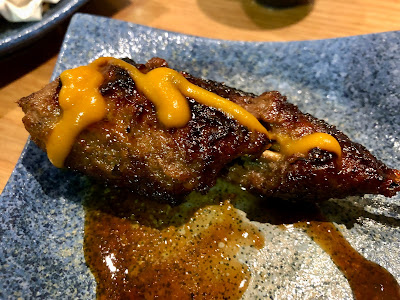The Japanese term "Yakitori" roughly translates as "grilled chicken," and it's said to extend back to at least the 17th century. In general, small pieces of meat, poultry or seafood are placed onto kushi (skewers), seasoned with tare sauce, and grilled over a charcoal fire.
The first mentions of yakitori in U.S. newspapers occurred in 1953, due to it being served at various functions at local Japanese embassies. The Knoxville News-Sentinel (TN), May 9, 1953, noted, “Yakitori is chicken strung on little skewers that look like knitting needles,..” The Daily Telegram (WI), September 11, 1953, mentioned that Crown Prince Akihito hosted a party at the embassy in Washington and served “Yakitori—Chicken and green onions broiled over charcoal.”
A recipe was then provided by the Chicago Tribune (IL), February 15, 1956. The article stated yakitori is “broiled skewered chicken and scallions, and the sauce is made with sake.” It then continued, “Yakitori. The name means broiled chicken, and while the dish usually is prepared over a charcoal fire outdoors, it may be prepared in an oven broiler.” In addition with the basic recipe, a simple recipe for the sauce was also given, mixing ¾ cup soy sauce, ¼ cup sugar and ¾ cup sake.
The first U.S. restaurants to serve yakitori started to appear around the late 1950s. For example, the Honolulu Star-Bulletin (HI), May 10, 1957, printed an advertisement for the Tokyo-Oasis, a café and night club that served yakitori. The San Francisco Chronicle (CA), January 18, 1959, noted that the Nikko restaurant served yakitori.
Another yakitori recipe, including the sauce, appeared in the Fort Lauderdale News (FL), December 24, 1959. Although the yakitori was generally prepared as in the prior recipe, the sauce was different, requiring a cup chicken soup, ½ cup soy sauce, 2 teaspoons sugar, 2 teaspoons salt, 2 teaspoons vinegar, 1 button of garlic, ginger and red pepper.
Another yakitori recipe, including the sauce, appeared in the Fort Lauderdale News (FL), December 24, 1959. Although the yakitori was generally prepared as in the prior recipe, the sauce was different, requiring a cup chicken soup, ½ cup soy sauce, 2 teaspoons sugar, 2 teaspoons salt, 2 teaspoons vinegar, 1 button of garlic, ginger and red pepper.
Today, yakitori is available in a variety of restaurants, including some that specialize in this Japanese treat. One such spot, Yakitori Totto, opened in December 2021 at Assembly Row in Somerville. The original Yakitori Totto opened in New York City in 2003, and the Somerville restaurant is only their
The Gyoza ($10) are pork and shiitake dumplings, which are hand made fresh daily. You don't see dumplings with such a crispy coating that often, and they were amply filled with a tasty blend of pork and mushrooms. A fine way to begin your lunch or dinner.
The Combo Mambo ($8) has eel, shrimp and scallop, a fine way to taste a few different types of seafood.
On the left is Bonchiri ($4.50), chicken tail, and on the right is Momo ($4), chicken thigh. Both are excellent, with the thigh being so tender and flavorful. The chicken tail would surprise you with its tender and moist taste. It's not the type of skewer you might consider at first, but it's worthwhile to experiment with some different chicken parts, and I suspect you'll find them delicious.
Overall, Yakitori Totto has incredible and scrumptious food, from its simplest skewers to its more complex, home-made dishes. It is reasonably priced, especially considering the quality of the dishes, and you can dine there inexpensively if you select only a few skewers, or you can splurge and experience many different dishes. I'd recommend trying something new when you dine there, to expand your culinary palate. I'll be returning there soon, looking forward to trying more of their cuisine.
second location. Over the last few weeks, I've dined twice at Yakitori Totto and both visits were impressive, with amazing food.
It's a medium-sized restaurant with a variety of tables as well as counter seating, where you can watch the cooks grilling the food. The restaurant is open for both lunch and dinner, and the menu is the same at both times. On my second visit, on a Saturday night, the restaurant was busy but they didn't try to rush us.
The Drinks menu is relatively small with 6 Beers ($6-$8), 3 Japanese whiskeys ($10-$40),
4 Wines (2 white, 2 red, $35-$50), and 11 Sakes (from $7.50 for a one-cup to $300 for a high-end bottle), and a variety of non-alcoholic drinks. On one visit, I was intrigued by the Forgotten Fortune Junmai ($75) but unfortunately it was out of stock. So, we opted for the Kaku Rei Junmai Daiginjo ($120), although I strongly suspect it wasn't actually a Junmai. The back label didn't indicate it was a Junmai, and some online research also tends to indicate it probably was a Honjozo rather than a Junmai.
The Sake was produced by the Aoki Brewery, which was founded in 1717, and made from the famed Yamada Nishika rice, which was milled down to 48%. It was an excellent Sake, with delicious peach and apple flavors, a touch of steamed rice, a nice body, and a lengthy finish. It was smooth and tasty, and went well with the grilled meats.
The Food menu has plenty of choices, and not just Yakitori. You can begin with Cold Appetizers, 10 choices for $7-$12, like Tako Wasa (marinated raw octopus) and Zaru Tofu (house made organic tofu). Or opt for some Hot Appetizers, 11 choices for $4-$12, such as Nasu Mizore Gaku (deep fried eggplant and mocha) and Fried Nankotsu (deep fried chicken knee bones).
The Yakitori options include Chicken, Limited Chicken, Pork, Totto Original, Beef, Vegetables, and Seafood, generally priced $3-$11 with many around $4-$5. There are also seven choices for Entrees, priced $12-$29, including items like Oyako Don (chicken and egg over rice), Prime Roasted Beef Don, and Una-Ju (barbecue eel over rice). Finally, there's 6 Sweets options, priced $5.50-$10, including Matcha Tea Affogato, Ice Banana, and Mochi Ice Cream.
Overall, there's plenty of variety, and everyone should be able to find dishes that appeal to their preferences, although it's also worthwhile to experiment and try some different dishes, which are more difficult to find elsewhere. How many restaurants do you know that serve Hiza Nankotsu, the soft knee bone of the chicken?
From the Cold Appetizers, the Maguro Zuke ($11) is a dish of tuna sashimi in a garlic infused, soy sauce, with wasabi. Silky and rich tuna slices, enhanced by the garlic and soy. What's not to love?
I also checked out several of the Hot Appetizers, including the Jidori Karaage ($9), Japanese style fried chicken, which comes with your choice of regular or sweet/spicy sauce. I opted for the sweet/spicy sauce, and the dish was excellent, with fresh, crispy pieces of fried chicken, with a well-balanced sauce and a nice touch of heat. These were some of the best karaage I've tasted and I highly recommend them.
The Gyoza ($10) are pork and shiitake dumplings, which are hand made fresh daily. You don't see dumplings with such a crispy coating that often, and they were amply filled with a tasty blend of pork and mushrooms. A fine way to begin your lunch or dinner.
I've always been a fan of Tamago Nigiri, and I've heard that in Japan, some assess the quality of a Sushi restaurant by how well they make their Tamago. The Dashi Maki Tamago ($9), is said to be a "Japanese soft rolled omelette." I wasn't expecting so many pieces of thick tamago, which was fresh, moist, eggy and flavorful. These felt like they were freshly made that day, and not pre-made tamago which you commonly find at many local sushi spots. This may seem like a simple dish, but there's more complexity to it than you realize.
The Agedashi Tofu ($9) consists of deep fried tofu in a dashi broth. This dish has two large squares of fried tofu, which have a thin fried skin atop them. They were creamy and rich, enhanced by the umami of the dashi broth, giving the tofu more flavor. I'm very picky about tofu, and this was definitely a winner.
One of my favorite appetizers was the Tori Dango ($12), chicken meatballs covered with seasoned mocha rice. I liked the slightly spiky exterior, which provided an excellent crunch, and the meatballs were firm, meaty and flavorful. There was a touch of sweetness to the crispy rice coating and a slight dip of soy sauce, added some umami to the dish. Highly recommended!
The Buta No Kakuni ($12) presents braised pork belly in soy sauce and dashi, with a hard boiled egg. The silky pork belly provided a nice blend of meat and fat, and again offered plenty of umami. The egg was a tasty addition, making this almost a breakfast dish, one I would enjoy any morning.
The Miso Soup ($4) was made with miso nameko mushrooms and tofu, and the broth was excellent, complex and flavorful. Even dishes such as this, which you can find at almost any Japanese restaurant, are elevated in quality and flavor here.
All of the Yakitori was delicious (as well as aesthetically pleasing) and I'm not going to go into detail on all of them, just the ones that especially stood out to me.
Yaki Nasu Miso Dengaku ($4), eggplant with miso paste
"Onigiri, the rice balls sold from convenience stores and packed for school lunches, become a different kind of treat at the yakitori shop. As cooks rotate skewers of meat and vegetables over hot charcoal, they also throw unwrapped, unfilled onigiri on the grill, basting them with a dead simple sauce until they’re smoky and crispy on the outside. They’re especially tasty after a little too much sake."
--Mastering the Art of Japanese Home Cooking by Masaharu Morimoto.
The Yaki Onigiri ($4.50), a grilled rice ball with your choice of soy, miso or yakitori sauce, was superb! I opted for the yakitori sauce, and loved the crispy outer rice, accented with sesame seeds and enhanced by the tare sauce. I ordered this on both visits, and loved it both times. It might be just rice, but it's prepared so well that it delights the palate.
Enoki Bacon ($5), bacon-wrapped mushrooms. Yum!
On the left is the Kalbi ($5.50), short ribs, and on the right is Negima ($4), chicken breast and scallions).
The Kawa ($4), chicken skin, is a pure delight, crispy, chewy, and flavorful. Anthony Bourdain previously raved about this chicken skin, and I understand why.
Wagyu Beef ($11)
The One And Only ($7) is a Japanese Waygu Beef Meatball, with a great crunchy exterior, seared well, and a moist and meaty interior. Decadent and delicious.
Tomato ($3), a very simple skewer, but I loved biting into the tomato in my mouth, feeling the hot juices squirt inside.
The Combo Mambo ($8) has eel, shrimp and scallop, a fine way to taste a few different types of seafood.
Another simple and tasty skewer. Garlic ($3) with miso.
On the left is Bonchiri ($4.50), chicken tail, and on the right is Momo ($4), chicken thigh. Both are excellent, with the thigh being so tender and flavorful. The chicken tail would surprise you with its tender and moist taste. It's not the type of skewer you might consider at first, but it's worthwhile to experiment with some different chicken parts, and I suspect you'll find them delicious.





























